TOYOTA iA 2016 (in English) Workshop Manual
Manufacturer: TOYOTA, Model Year: 2016, Model line: iA, Model: TOYOTA iA 2016Pages: 588, PDF Size: 5.15 MB
Page 51 of 588
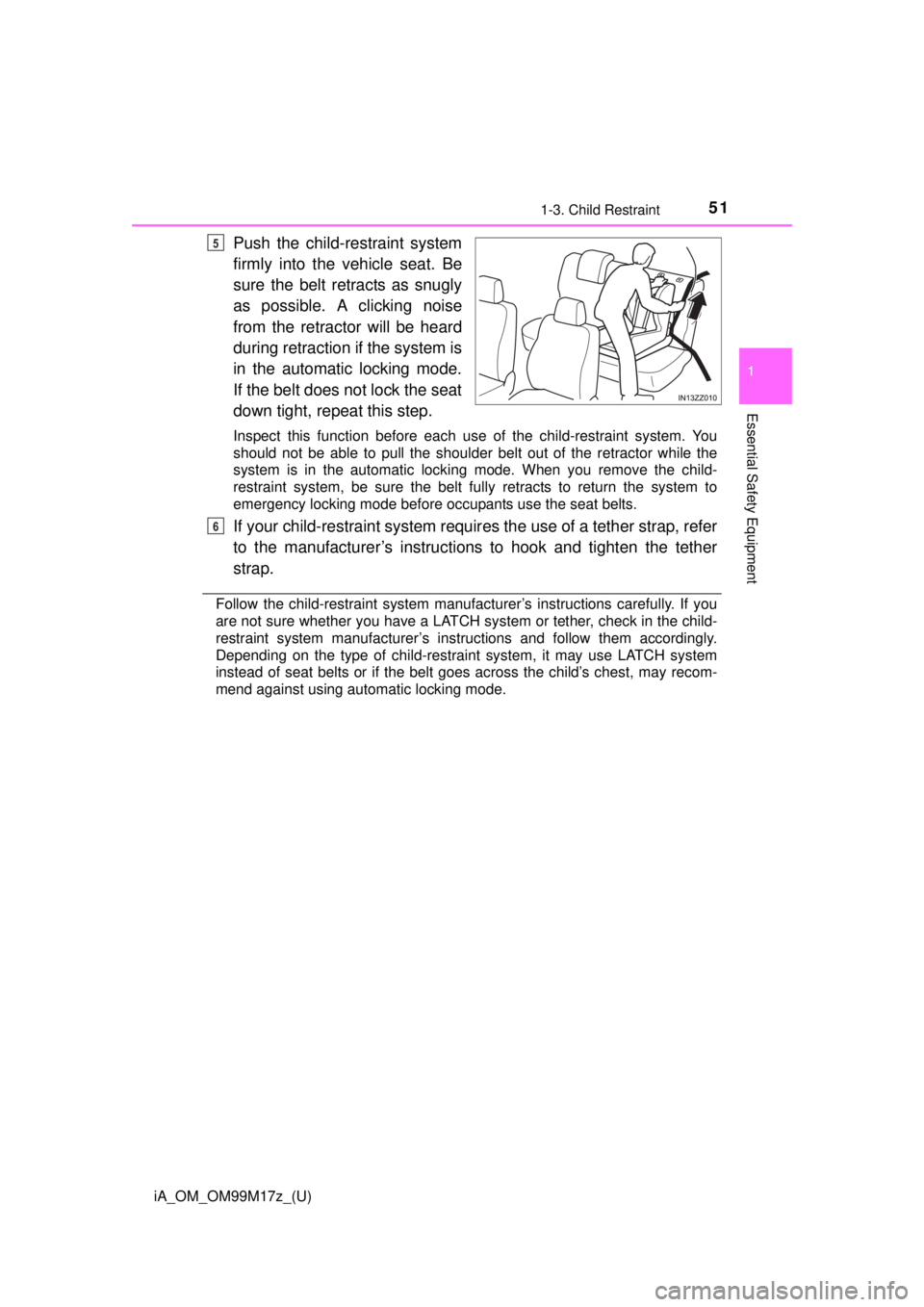
iA_OM_OM99M17z_(U)
511-3. Child Restraint
1
Essential Safety Equipment
Push the child-restraint system
firmly into the vehicle seat. Be
sure the belt retracts as snugly
as possible. A clicking noise
from the retractor will be heard
during retraction if the system is
in the automatic locking mode.
If the belt does not lock the seat
down tight, repeat this step.
Inspect this function before each use of the child-restraint system. You
should not be able to pull the shoulder belt out of the retractor while the
system is in the automatic locking mode. When you remove the child-
restraint system, be sure the belt fully retracts to return the system to
emergency locking mode before occupants use the seat belts.
If your child-restraint system requires the use of a tether strap, refer
to the manufacturer’s instructi ons to hook and tighten the tether
strap.
Follow the child-restraint system manufacturer’s instructions carefully. If you
are not sure whether you have a LATCH system or tether, check in the child-
restraint system manufacturer’s instructions and follow them accordingly.
Depending on the type of child-restraint system, it may use LATCH system
instead of seat belts or if the belt goes across the child’s chest, may recom-
mend against using automatic locking mode.
5
6
Page 52 of 588
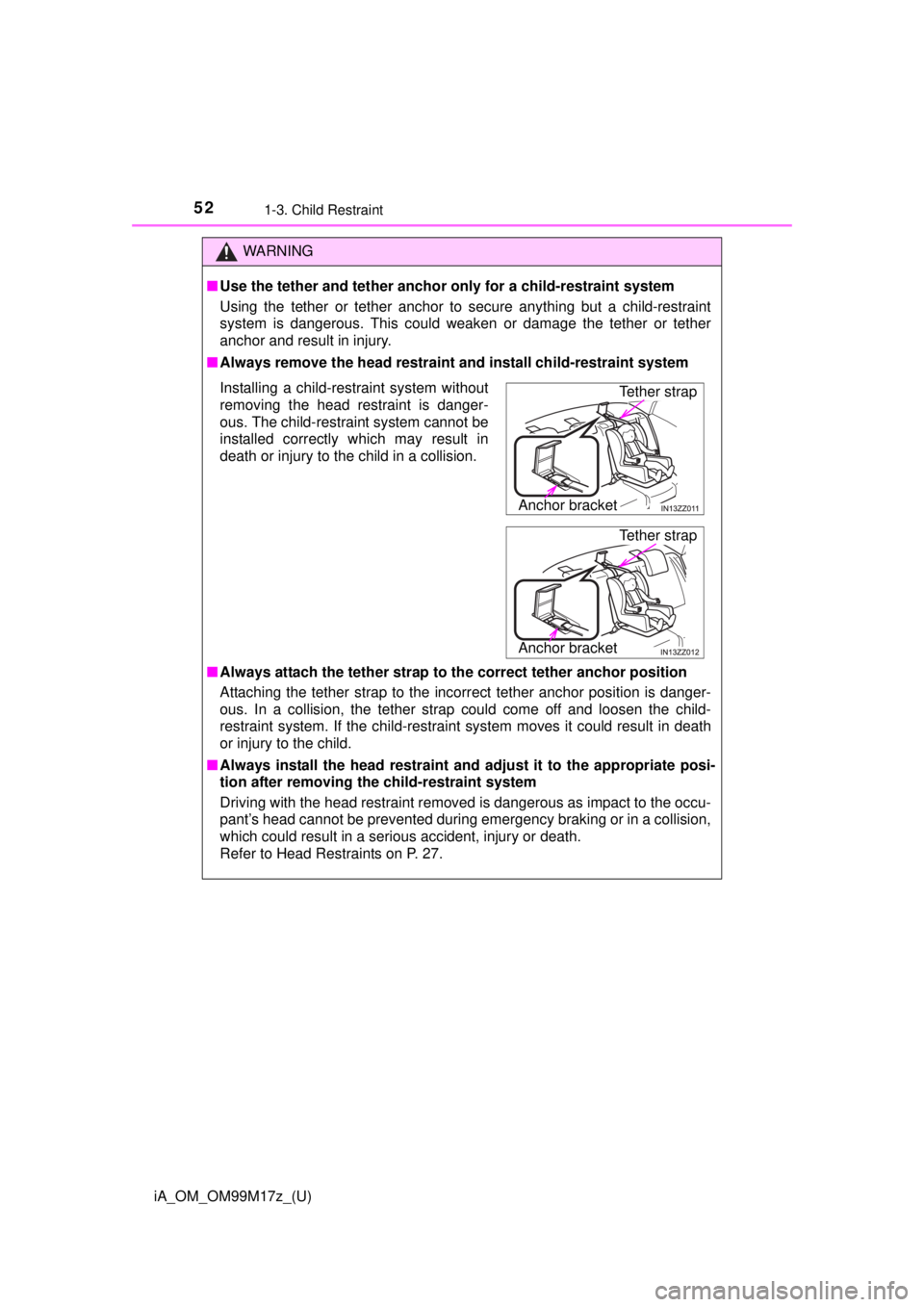
52
iA_OM_OM99M17z_(U)
1-3. Child Restraint
WARNING
■Use the tether and tether anchor only for a child-restraint system
Using the tether or tether anchor to secure anything but a child-restraint
system is dangerous. This could weaken or damage the tether or tether
anchor and result in injury.
■ Always remove the head restraint and install child-restraint system
■ Always attach the tether strap to the correct tether anchor position
Attaching the tether strap to the incorrect tether anchor position is danger-
ous. In a collision, the tether strap could come off and loosen the child-
restraint system. If the child-restraint system moves it could result in death
or injury to the child.
■ Always install the head restraint and adjust it to the appropriate posi-
tion after removing the child-restraint system
Driving with the head restraint removed is dangerous as impact to the occu-
pant’s head cannot be prevented during emergency braking or in a collision,
which could result in a serious accident, injury or death.
Refer to Head Restraints on P. 27.
Installing a child-restraint system without
removing the head restraint is danger-
ous. The child-restraint system cannot be
installed correctly which may result in
death or injury to the child in a collision.Tether strap
Anchor bracket
Anchor bracket
Tether strap
Page 53 of 588
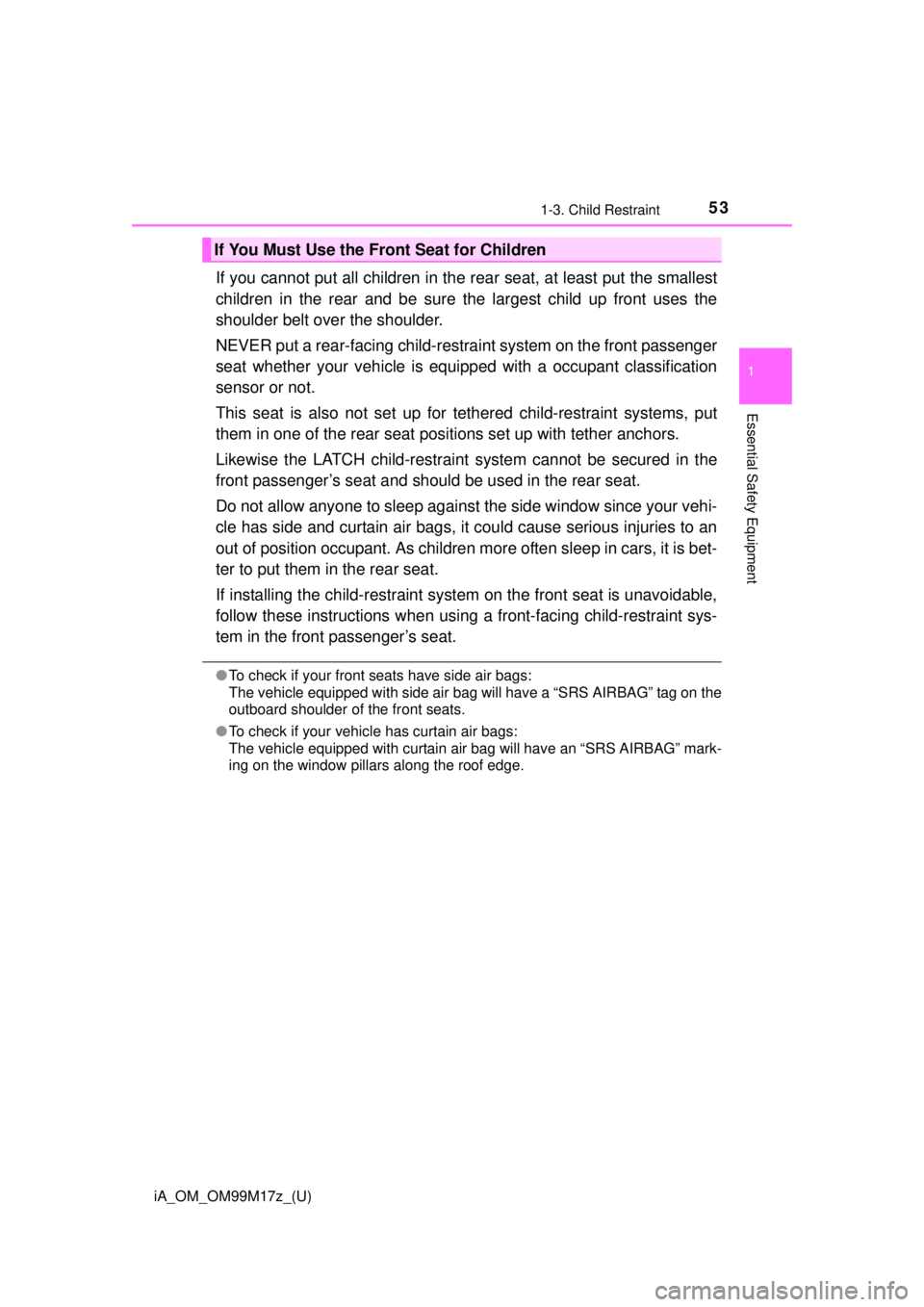
iA_OM_OM99M17z_(U)
531-3. Child Restraint
1
Essential Safety Equipment
If you cannot put all children in the rear seat, at least put the smallest
children in the rear and be sure the largest child up front uses the
shoulder belt over the shoulder.
NEVER put a rear-facing child-restraint system on the front passenger
seat whether your vehicle is equipped with a occupant classification
sensor or not.
This seat is also not set up for te thered child-restraint systems, put
them in one of the rear seat pos itions set up with tether anchors.
Likewise the LATCH child-restraint system cannot be secured in the
front passenger’s seat and should be used in the rear seat.
Do not allow anyone to sleep against the side window since your vehi-
cle has side and curtain air bags, it could cause serious injuries to an
out of position occupant. As children more often sleep in cars, it is bet-
ter to put them in the rear seat.
If installing the child-restraint system on the front seat is unavoidable,
follow these instructions when usin g a front-facing child-restraint sys-
tem in the front passenger’s seat.
● To check if your front seats have side air bags:
The vehicle equipped with side air bag will have a “SRS AIRBAG” tag on the
outboard shoulder of the front seats.
● To check if your vehicle has curtain air bags:
The vehicle equipped with curtain air bag will have an “SRS AIRBAG” mark-
ing on the window pillars along the roof edge.
If You Must Use the Front Seat for Children
Page 54 of 588
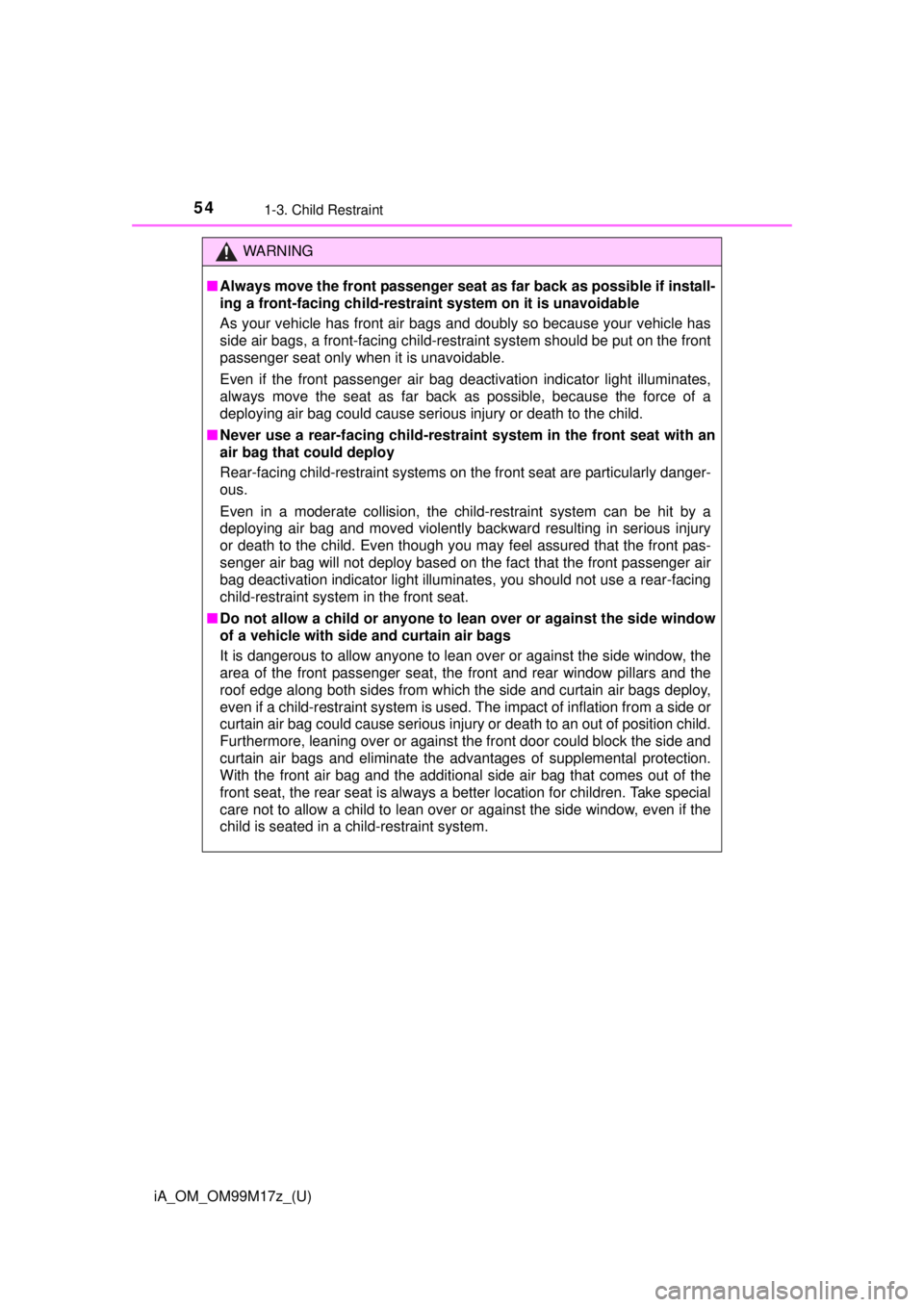
54
iA_OM_OM99M17z_(U)
1-3. Child Restraint
WARNING
■Always move the front passenger seat as far back as possible if install-
ing a front-facing ch ild-restraint system on it is unavoidable
As your vehicle has front air bags and doubly so because your vehicle has
side air bags, a front-facing child-restraint system should be put on the front
passenger seat only when it is unavoidable.
Even if the front passenger air bag deactivation indicator light illuminates,
always move the seat as far back as possible, because the force of a
deploying air bag could cause serious injury or death to the child.
■ Never use a rear-facing child-restra int system in the front seat with an
air bag that could deploy
Rear-facing child-restraint systems on the front seat are particularly danger-
ous.
Even in a moderate collision, the child-restraint system can be hit by a
deploying air bag and moved violently backward resulting in serious injury
or death to the child. Even though you may feel assured that the front pas-
senger air bag will not deploy based on the fact that the front passenger air
bag deactivation indicator light illuminates, you should not use a rear-facing
child-restraint system in the front seat.
■ Do not allow a child or anyone to lean over or against the side window
of a vehicle with side and curtain air bags
It is dangerous to allow anyone to lean over or against the side window, the
area of the front passenger seat, the front and rear window pillars and the
roof edge along both sides from which the side and curtain air bags deploy,
even if a child-restraint system is used. The impact of inflation from a side or
curtain air bag could cause serious injury or death to an out of position ch\
ild.
Furthermore, leaning over or against t he front door could block the side and
curtain air bags and eliminate the adv antages of supplemental protection.
With the front air bag and the additional side air bag that comes out of the
front seat, the rear seat is always a better location for children. Take special
care not to allow a child to lean over or against the side window, even if the
child is seated in a child-restraint system.
Page 55 of 588
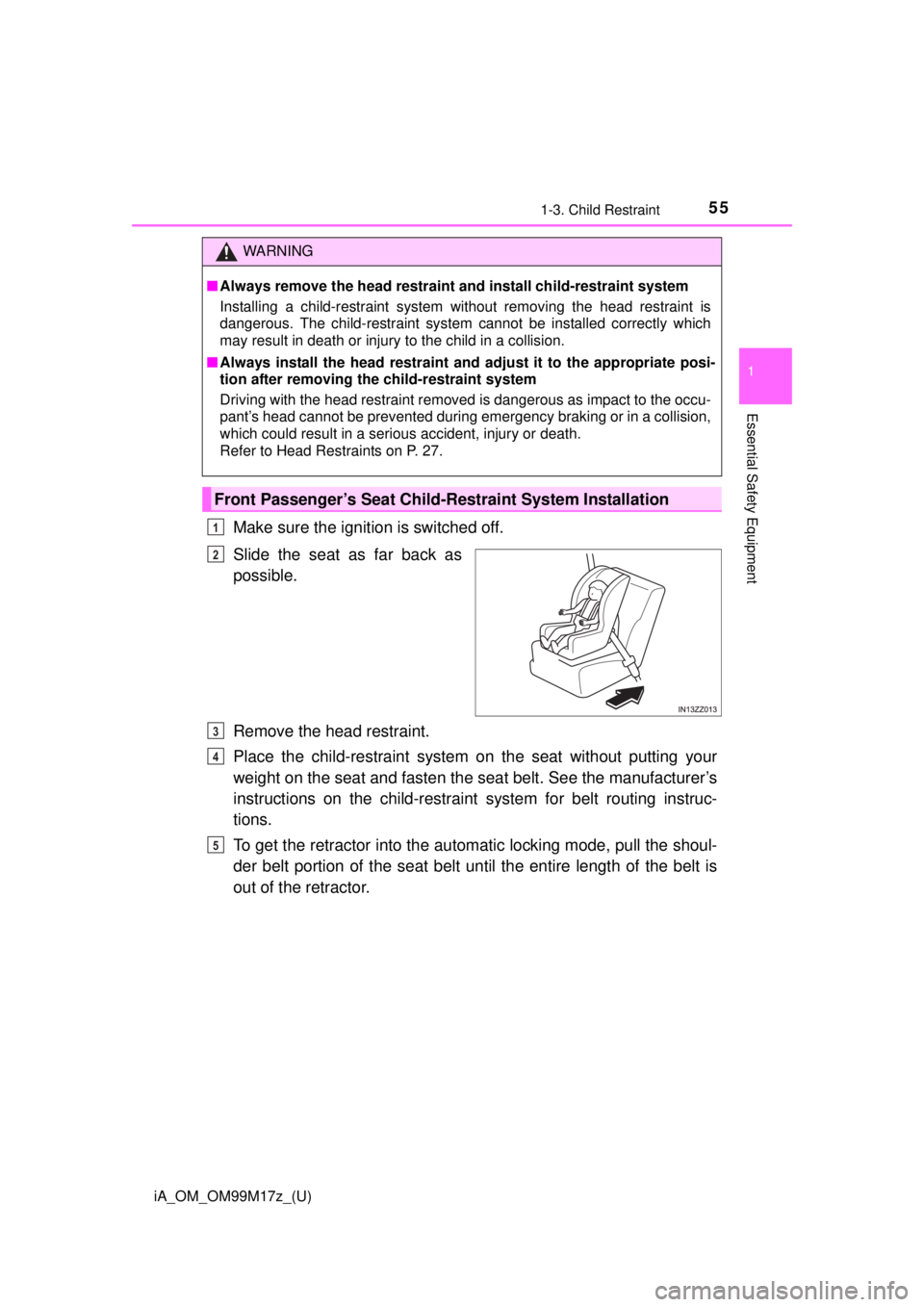
iA_OM_OM99M17z_(U)
551-3. Child Restraint
1
Essential Safety Equipment
Make sure the ignition is switched off.
Slide the seat as far back as
possible.
Remove the head restraint.
Place the child-restraint system on the seat without putting your
weight on the seat and fasten the seat belt. See the manufacturer’s
instructions on the ch ild-restraint system for belt routing instruc-
tions.
To get the retractor into the autom atic locking mode, pull the shoul-
der belt portion of the seat belt until the entire length of the belt is
out of the retractor.
WARNING
■ Always remove the head restraint and install child-restraint system
Installing a child-restraint system without removing the head restraint is
dangerous. The child-restraint system cannot be installed correctly which
may result in death or injury to the child in a collision.
■ Always install the head restraint and adjust it to the appropriate posi-
tion after removing the child-restraint system
Driving with the head restraint removed is dangerous as impact to the occu-
pant’s head cannot be prevented during emergency braking or in a collision,
which could result in a serious accident, injury or death.
Refer to Head Restraints on P. 27.
Front Passenger’s Seat Child-Restraint System Installation
1
2
3
4
5
Page 56 of 588
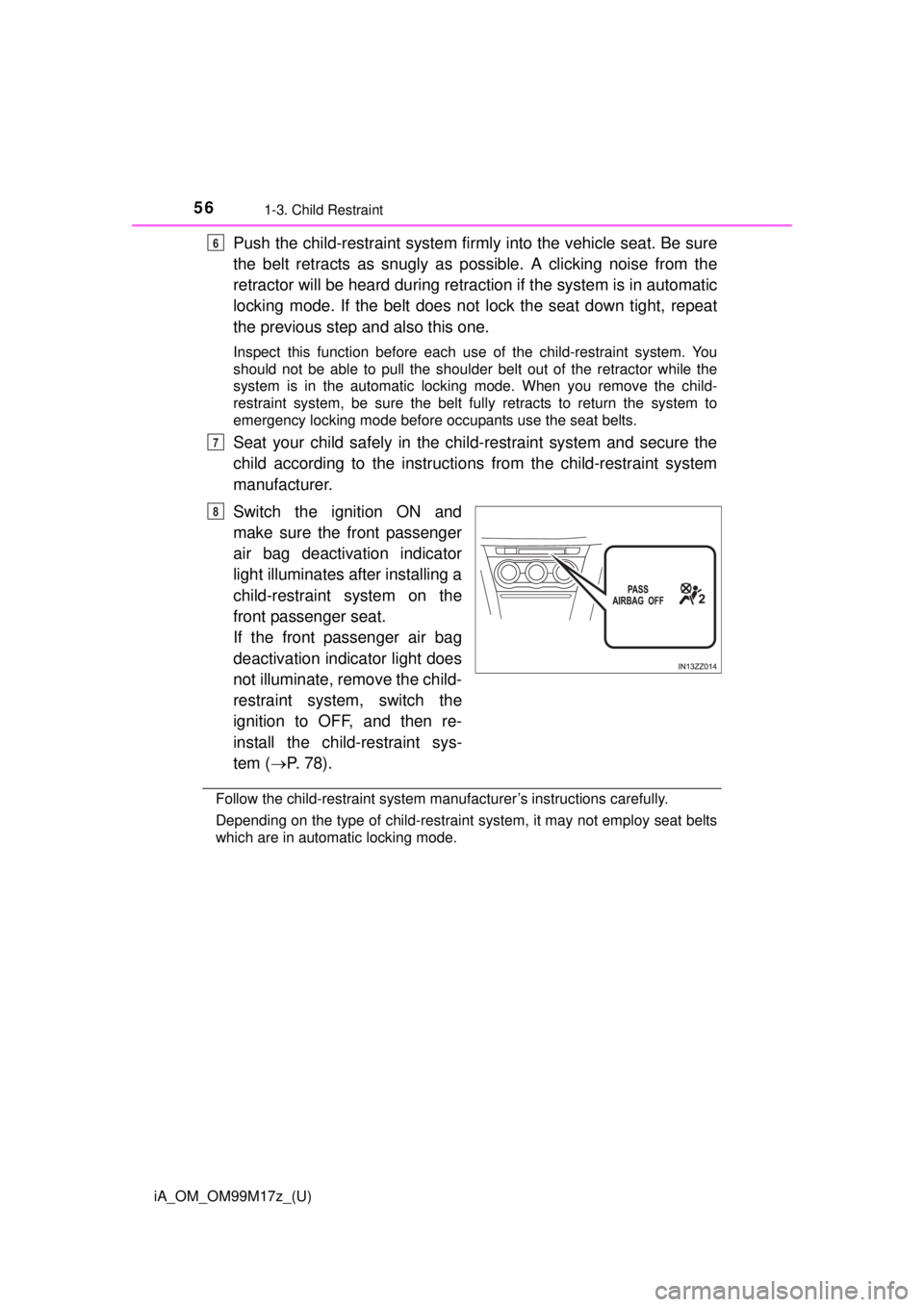
56
iA_OM_OM99M17z_(U)
1-3. Child Restraint
Push the child-restraint system firmly into the vehicle seat. Be sure
the belt retracts as snugly as possible. A clicking noise from the
retractor will be heard during retracti on if the system is in automatic
locking mode. If the belt does not lock the seat down tight, repeat
the previous step and also this one.
Inspect this function before each use of the child-restraint system. You
should not be able to pull the shoulder belt out of the retractor while the
system is in the automatic locking mode. When you remove the child-
restraint system, be sure the belt fully retracts to return the system to
emergency locking mode before occupants use the seat belts.
Seat your child safely in the child-restraint system and secure the
child according to the instructio ns from the child-restraint system
manufacturer.
Switch the ignition ON and
make sure the front passenger
air bag deactivation indicator
light illuminates after installing a
child-restraint system on the
front passenger seat.
If the front passenger air bag
deactivation indicator light does
not illuminate, remove the child-
restraint system, switch the
ignition to OFF, and then re-
install the child-restraint sys-
tem ( P. 78).
Follow the child-restraint system manufacturer’s instructions carefully.
Depending on the type of child-restraint system, it may not employ seat belts
which are in automatic locking mode.
6
7
8
Page 57 of 588
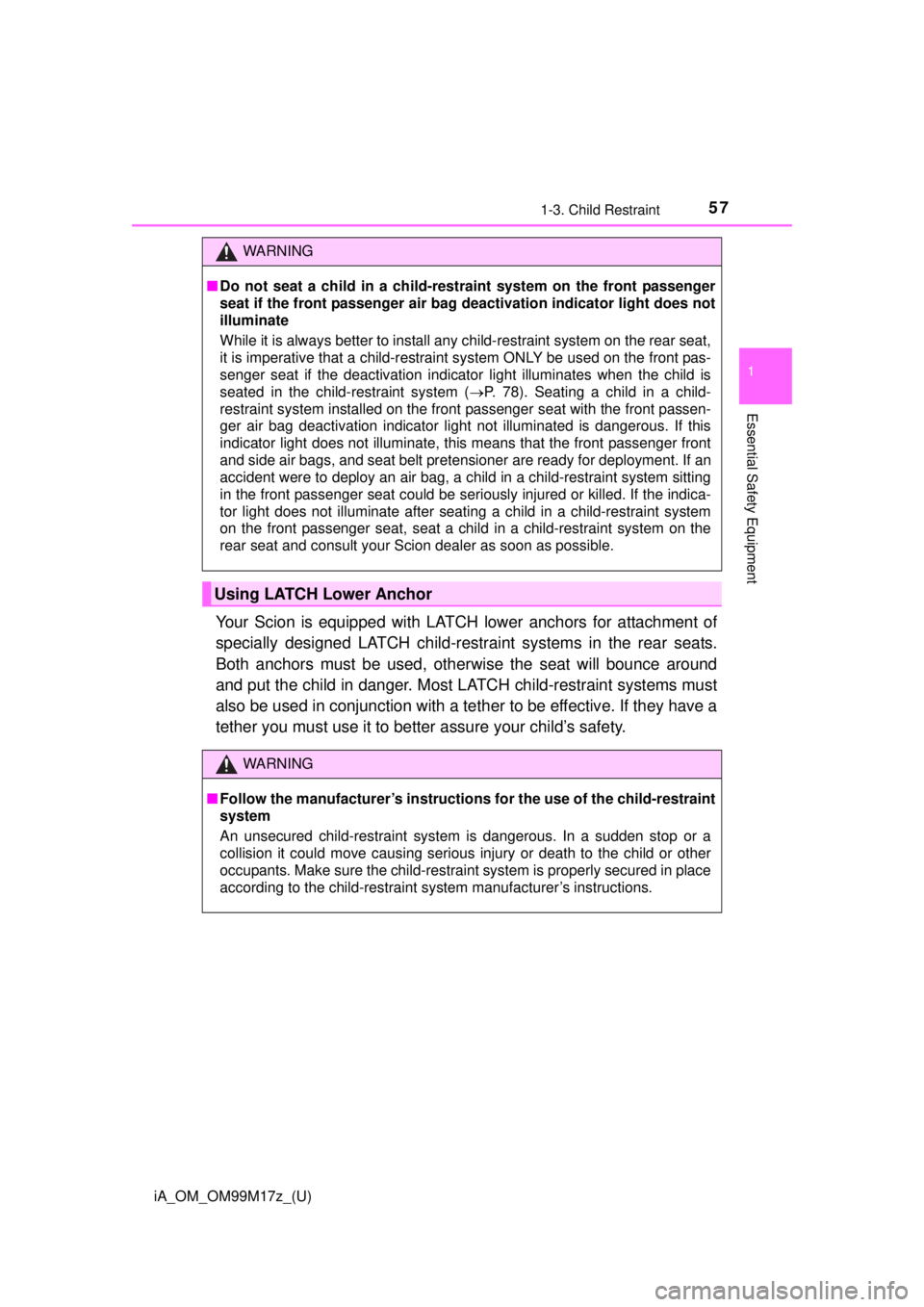
iA_OM_OM99M17z_(U)
571-3. Child Restraint
1
Essential Safety Equipment
Your Scion is equipped with LATCH lower anchors for attachment of
specially designed LATCH child-restraint systems in the rear seats.
Both anchors must be used, otherwise the seat will bounce around
and put the child in danger. Most LATCH child-restraint systems must
also be used in conjunction with a te ther to be effective. If they have a
tether you must use it to better assure your child’s safety.
WARNING
■ Do not seat a child in a child-rest raint system on the front passenger
seat if the front passenger air bag d eactivation indicator light does not
illuminate
While it is always better to install any child-restraint system on the rear seat,
it is imperative that a child-restraint system ONLY be used on the front pas-
senger seat if the deactivation indicator light illuminates when the child is
seated in the child-restraint system ( P. 78). Seating a child in a child-
restraint system installed on the front passenger seat with the front passen-
ger air bag deactivation indicator light not illuminated is dangerous. If this
indicator light does not illuminate, this means that the front passenger front
and side air bags, and seat belt pretensi oner are ready for deployment. If an
accident were to deploy an air bag, a child in a child-restraint system sitting
in the front passenger seat could be seriously injured or killed. If the indica-
tor light does not illuminate after seating a child in a child-restraint system
on the front passenger seat, seat a child in a child-restraint system on the
rear seat and consult your Scion dealer as soon as possible.
Using LATCH Lower Anchor
WARNING
■ Follow the manufacturer’s instructions for the use of the child-restraint
system
An unsecured child-restraint system is dangerous. In a sudden stop or a
collision it could move causing serious injury or death to the child or other
occupants. Make sure the child-restraint system is properly secured in place
according to the child-restraint system manufacturer’s instructions.
Page 58 of 588
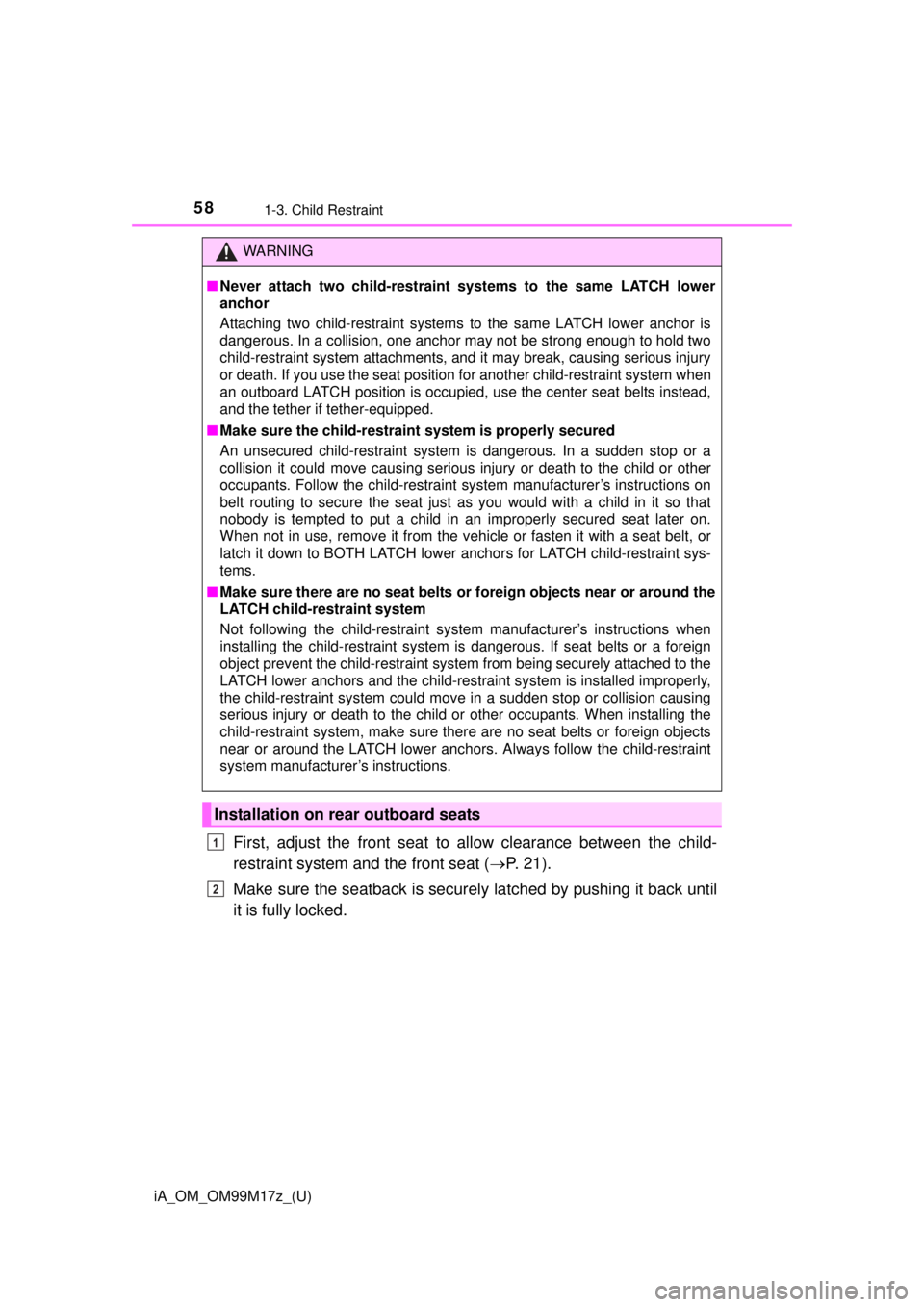
58
iA_OM_OM99M17z_(U)
1-3. Child Restraint
First, adjust the front seat to allow clearance between the child-
restraint system and the front seat ( P. 2 1 ) .
Make sure the seatback is securely latched by pushing it back until
it is fully locked.
WARNING
■ Never attach two child-restrain t systems to the same LATCH lower
anchor
Attaching two child-restraint systems to the same LATCH lower anchor is
dangerous. In a collision, one anchor may not be strong enough to hold two
child-restraint system attachments, and it may break, causing serious injury
or death. If you use the seat position for another child-restraint system when
an outboard LATCH position is occupied, use the center seat belts instead,
and the tether if tether-equipped.
■ Make sure the child-restraint system is properly secured
An unsecured child-restraint system is dangerous. In a sudden stop or a
collision it could move causing serious injury or death to the child or other
occupants. Follow the child-restraint system manufacturer’s instructions on
belt routing to secure the seat just as you would with a child in it so that
nobody is tempted to put a child in an improperly secured seat later on.
When not in use, remove it from the vehicle or fasten it with a seat belt, or
latch it down to BOTH LATCH lower anchors for LATCH child-restraint sys-
tems.
■ Make sure there are no seat belts or foreign objects near or around the
LATCH child-restraint system
Not following the child-restraint system manufacturer’s instructions when
installing the child-restraint system is dangerous. If seat belts or a foreign
object prevent the child-restraint system from being securely attached to the
LATCH lower anchors and the child-restraint system is installed improperly,
the child-restraint system could move in a sudden stop or collision causing
serious injury or death to the child or other occupants. When installing the
child-restraint system, make sure there are no seat belts or foreign objects
near or around the LATCH lower anchors. Always follow the child-restraint
system manufacturer’s instructions.
Installation on rear outboard seats
1
2
Page 59 of 588
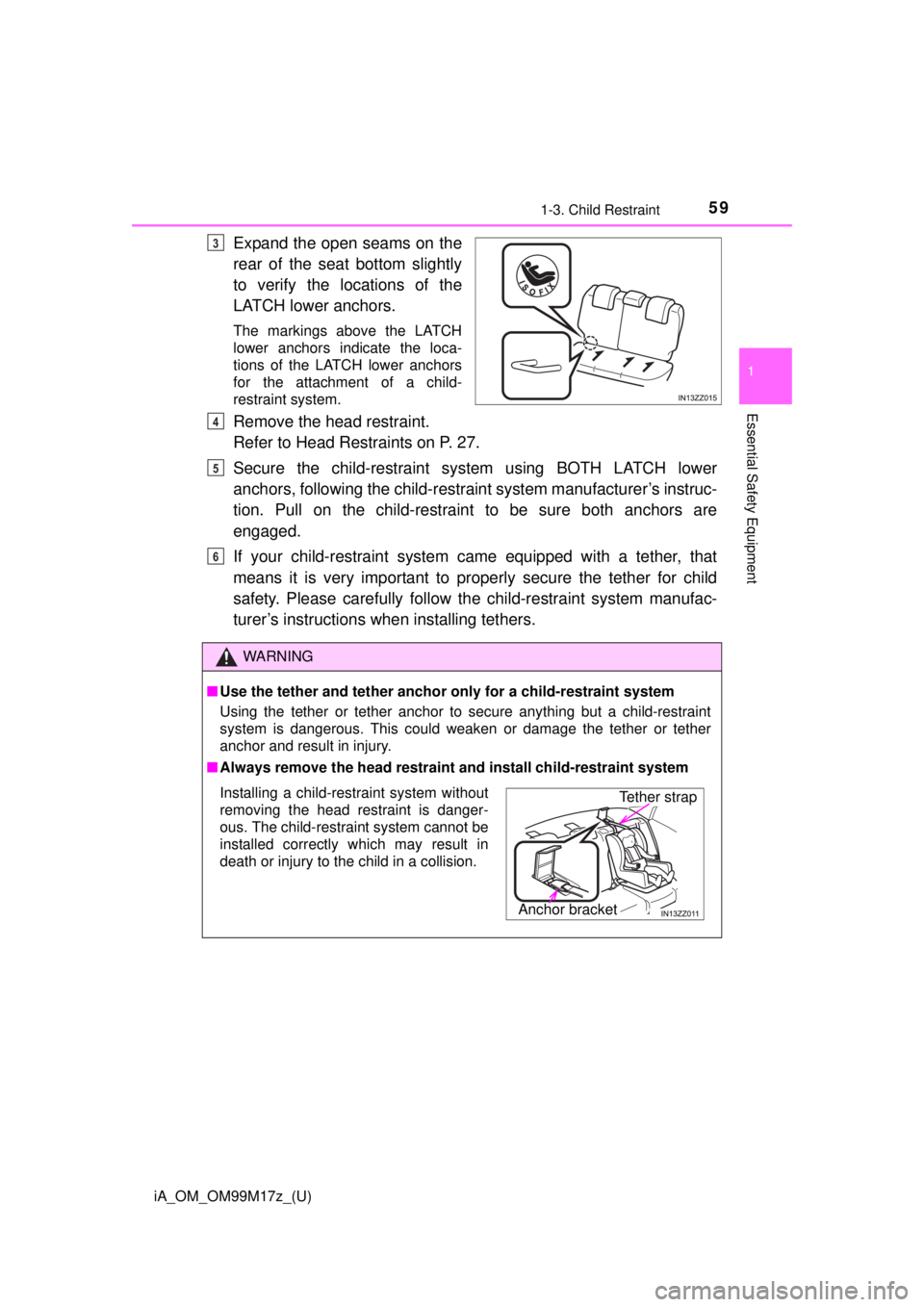
iA_OM_OM99M17z_(U)
591-3. Child Restraint
1
Essential Safety Equipment
Expand the open seams on the
rear of the seat bottom slightly
to verify the locations of the
LATCH lower anchors.
The markings above the LATCH
lower anchors indicate the loca-
tions of the LATCH lower anchors
for the attachment of a child-
restraint system.
Remove the head restraint.
Refer to Head Restraints on P. 27.
Secure the child-restraint system using BOTH LATCH lower
anchors, following the child-restraint system manufacturer’s instruc-
tion. Pull on the child-restraint to be sure both anchors are
engaged.
If your child-restraint system came equipped with a tether, that
means it is very important to properly secure the tether for child
safety. Please carefully follow the child-restraint system manufac-
turer’s instructions when installing tethers.
3
WARNING
■ Use the tether and tether anchor only for a child-restraint system
Using the tether or tether anchor to secure anything but a child-restraint
system is dangerous. This could weaken or damage the tether or tether
anchor and result in injury.
■ Always remove the head restraint and install child-restraint system
4
5
6
Installing a child-restraint system without
removing the head restraint is danger-
ous. The child-restraint system cannot be
installed correctly which may result in
death or injury to the child in a collision.
Anchor bracket
Tether strap
Page 60 of 588
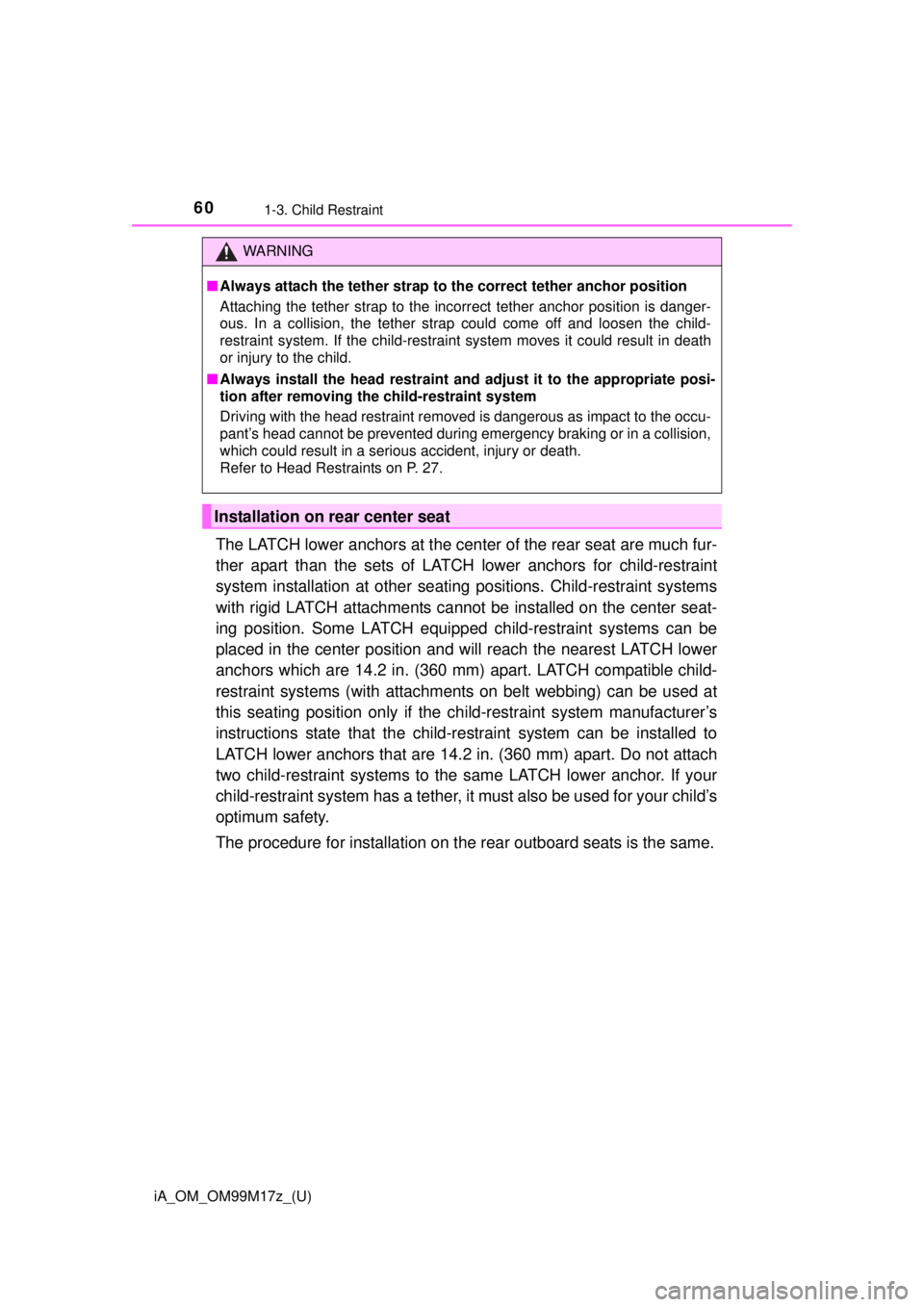
60
iA_OM_OM99M17z_(U)
1-3. Child Restraint
The LATCH lower anchors at the center of the rear seat are much fur-
ther apart than the sets of LATCH lower anchors for child-restraint
system installation at other seating positions. Child-restraint systems
with rigid LATCH attachments cannot be installed on the center seat-
ing position. Some LATCH equipped child-restraint systems can be
placed in the center position and will reach the nearest LATCH lower
anchors which are 14.2 in. (360 mm) apart. LATCH compatible child-
restraint systems (with attachments on belt webbing) can be used at
this seating position only if the ch ild-restraint system manufacturer’s
instructions state that the child-r estraint system can be installed to
LATCH lower anchors that are 14.2 in. (360 mm) apart. Do not attach
two child-restraint systems to the same LATCH lower anchor. If your
child-restraint system has a tether, it must also be used for your child’s
optimum safety.
The procedure for installation on the rear outboard seats is the same.
WARNING
■ Always attach the tether strap to the correct tether anchor position
Attaching the tether strap to the incorrect tether anchor position is danger-
ous. In a collision, the tether strap could come off and loosen the child-
restraint system. If the child-restraint system moves it could result in death
or injury to the child.
■ Always install the head restraint and adjust it to the appropriate posi-
tion after removing the child-restraint system
Driving with the head restraint removed is dangerous as impact to the occu-
pant’s head cannot be prevented during emergency braking or in a collision,
which could result in a serious accident, injury or death.
Refer to Head Restraints on P. 27.
Installation on rear center seat